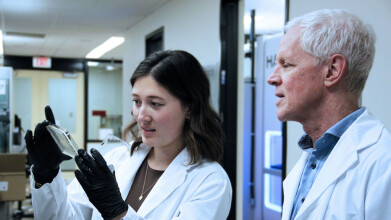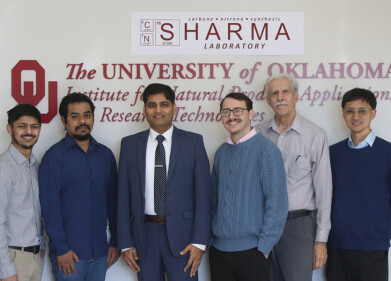-
 [From left] Principal author Megan Tu and Professor Eric Brown, both of the Brown Lab, have discovered new vulnerabilities in some of the world’s most drug-resistant bacteria. Picture: Blake Dillon, McMaster University
[From left] Principal author Megan Tu and Professor Eric Brown, both of the Brown Lab, have discovered new vulnerabilities in some of the world’s most drug-resistant bacteria. Picture: Blake Dillon, McMaster University
Research News
Viva la resistance: Researchers at McMaster University find second life for old antibiotics
Jan 10 2025
In a study, published in the journal Nature Microbiology, a research team at the Canadian institution of McMaster University in Hamilton, has found that zinc plays a vital role in by which bacteria resist antibiotics.
Professor Eric Brown of McMaster’s Department of Biochemistry and Biomedical Sciences, and lead investigator on the study, says depriving bacteria of certain nutrients can cause make them more vulnerable to antibiotics ─ including to those which they have been resistant.
“For the past hundred years or so, scientists have typically studied bacteria in the richest conditions imaginable,” said Brown.
“My lab [is] doing exactly the opposite… studying bacteria under nutrient stress.”
In this study, the team examined how nutrient stress might reveal novel approaches to treat bacterial infections that have shown resistance to the class of antibiotics called carbapenems.
“Carbapenems are last-resort antibiotics ─ clinically significant drugs that are used when everything else fails. Unfortunately, like other antibiotics, their efficacy is being threatened by [increasing levels of] resistance.” said Megan Tu, first author on the article and a doctoral candidate at the Brown Lab.
The researchers sought to discover if there were vulnerabilities in the drug-resistant bacteria when treated in a zinc-limited environment. Under these conditions, they found that the bacteria’s ability to resist carbapenems came with a ‘fitness cost’ ─ analogous to a trade-off between defence and attack.
Brown described the bacteria under these conditions as a ‘knight in armour’ ─ a sword in one hand and a shield in the other ─ but the lack of zinc means that it needs to lay down its shield so that it can hold its sword with both hands.
“It’s still very deadly, but now it’s defences are down,” he explained.
ILM WEBINAR SERIES 2025 – BOOK NOW
Losing that shield creates openings in the bacteria that can be exploited by using other antibiotics alongside the carbapenems.
Tu et al showed that, by resisting carbapenems in zinc-limited conditions, the bacteria were left open to azithromycin ─ one of the most commonly prescribed antibiotics in the world.
“Rather than identifying a novel drug candidate to treat these antibiotic-resistant infections, we’ve identified a trade-off that we can exploit using an existing drug,” said Tu.
The study focused on Klebsiella pneumoniae and Pseudomonas aeruginosa ─ the bacteria that are ‘K’ and ‘P’ in ‘ESKAPE’, ─ the six most deadly and drug-resistant bacterial pathogens prioritised by the World Health Organization.
Both bacteria studied are a type called ‘gram-negative’, which are not traditionally affected by azithromycin. The researchers believe their study has opened up a new clinical utility for old drugs, while also cementing nutrient stress as a viable treatment pathway for drug-resistance.
“This study is one of those rare cases that actually culminates in resounding conclusion. [It is possible to] treat certain drug-resistant Kleb and Pseudomonas infections with azithromycin.”
For further reading please visit: 10.1038/s41564-024-01883-8
Digital Edition
Lab Asia 31.6 Dec 2024
December 2024
Chromatography Articles - Sustainable chromatography: Embracing software for greener methods Mass Spectrometry & Spectroscopy Articles - Solving industry challenges for phosphorus containi...
View all digital editions
Events
Jan 22 2025 Tokyo, Japan
Jan 22 2025 Birmingham, UK
Jan 25 2025 San Diego, CA, USA
Jan 27 2025 Dubai, UAE
Jan 29 2025 Tokyo, Japan


















